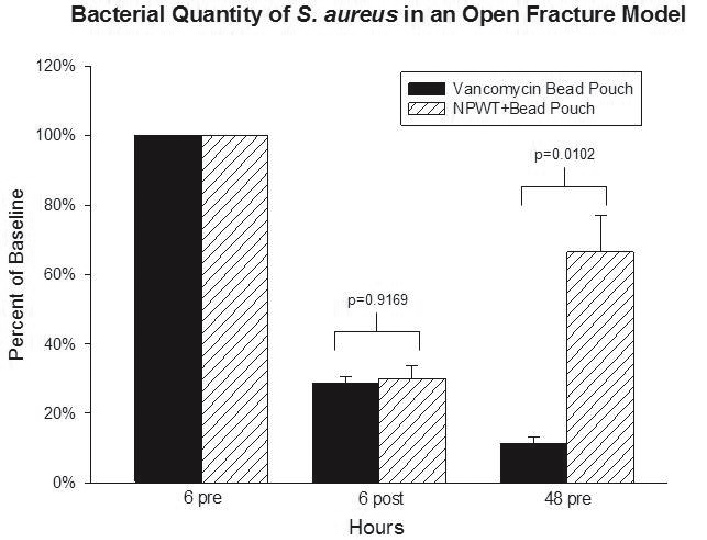
Sat., 10/16/10 Polytrauma & Femur, Paper #70, 10:46 am OTA-2010
•Negative Pressure Wound Therapy (NPWT) Reduces Effectiveness of Antibiotic Beads
CPT Daniel J. Stinner, MD; MAJ(P) Joseph R. Hsu, MD; Joseph C. Wenke, MD;
United States Army Institute of Surgical Research, Fort Sam Houston, Texas, USA
Purpose: Negative pressure wound therapy (NPWT) is commonly used as an effective
wound management technique. Compared to wet to dry dressings, it has been shown to
have a favorable effect on minimizing bacteria in wounds contaminated with Pseudomonas
aeruginosa, but not with Staphylococcus aureus. Adjunctive treatments, to include the addition
of local antibiotics, offer an attractive alternative to NPWT alone, but there is concern that
the antibiotics will be removed from the wound milieu. This study evaluates the ability of
antibiotic-impregnated polymethylmethacrylate (PMMA) beads used in conjunction with
NPWT to minimize infection in contaminated wounds compared to the standard antibiotic
bead pouch.
Methods: A complex musculoskeletal wound was created on the hindlimb of 20 goats and contaminated with S. aureus (lux) bacteria. The bacteria are genetically engineered to emit photons, allowing for quantification with a photon-counting camera system. The wounds were débrided and irrigated 6 hours after inoculation. Goats were assigned to two different treatment groups: a control group using an antibiotic bead pouch and an experimental group using NPWT in conjunction with antibiotic beads. The wounds were evaluated 48 hours after contamination and the bacteria within the wounds were quantified. NPWT effluent levels of antibiotic were measured at 6, 12, 24, 36, and 42 hours after treatment was initiated.
Results: The bacterial load was significantly minimized in wounds treated with the antibiotic bead pouch when compared to treatment with NPWT and antibiotic beads (P < 0.05). High levels of antibiotic were consistently recovered from NPWT effluent samples at all time points (51 ± 3 μg/mL).
Conclusion: As suspected, antibiotic was found in the NPWT effluent in wounds treated with NPWT and antibiotic beads, which decreased its effectiveness when compared to the antibiotic bead pouch. When comparing previous data using an identical musculoskeletal wound model, NPWT with antibiotic beads remains more effective than NPWT alone. Thus, consideration must be given to the indications and desired outcomes of the different treatment options. If infection control is the surgeon’s primary concern, the antibiotic bead pouch is most effective. If both infection control and wound management are priorities, the addition of antibiotic beads to NPWT does appear beneficial when compared to previous studies using NPWT alone.

Alphabetical Disclosure Listing (292K PDF)
• The FDA has not cleared this drug and/or medical device for the use described in this presentation (i.e., the drug or medical device is being discussed for an “off label” use). ◆FDA information not available at time of printing. Δ OTA Grant.